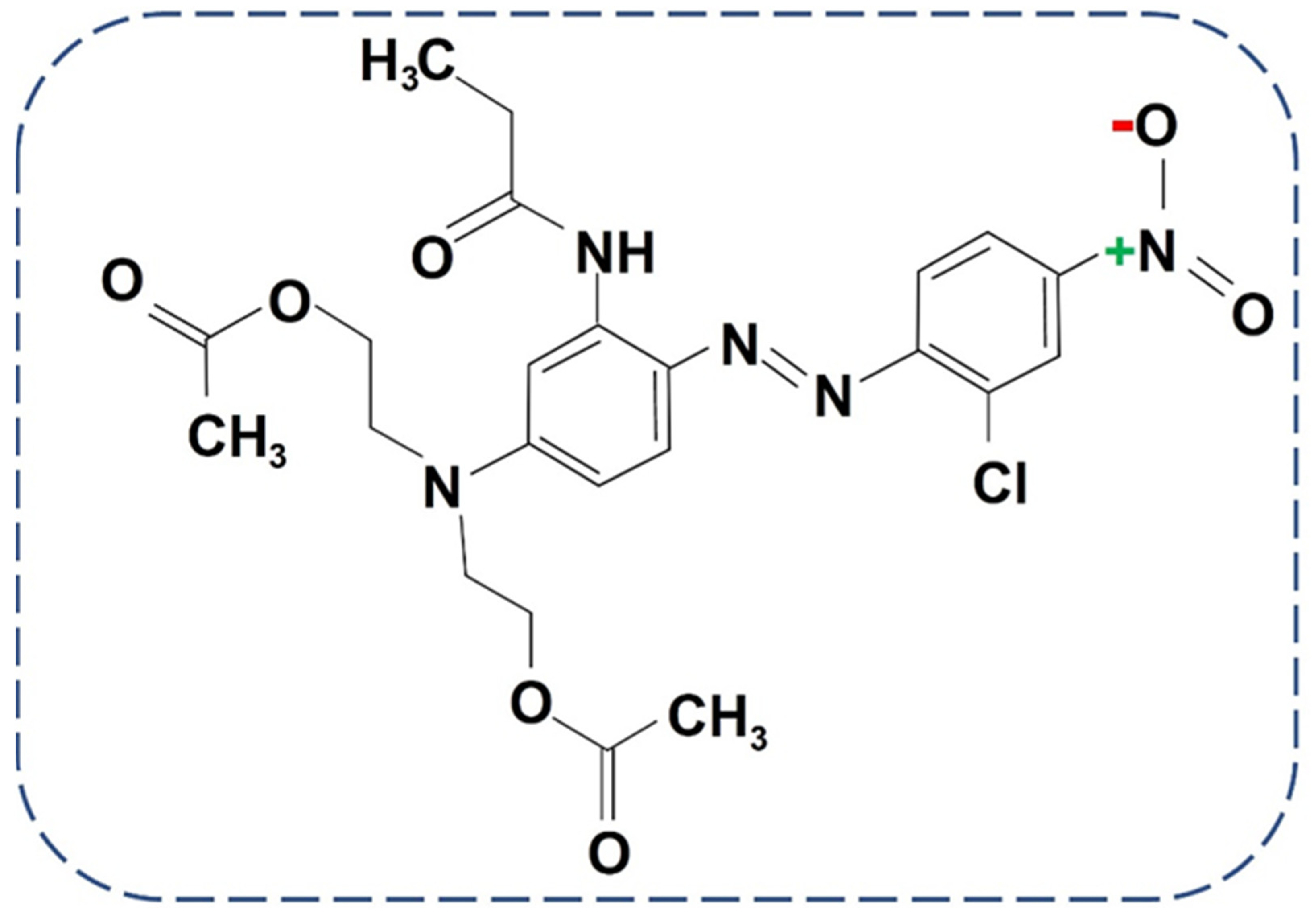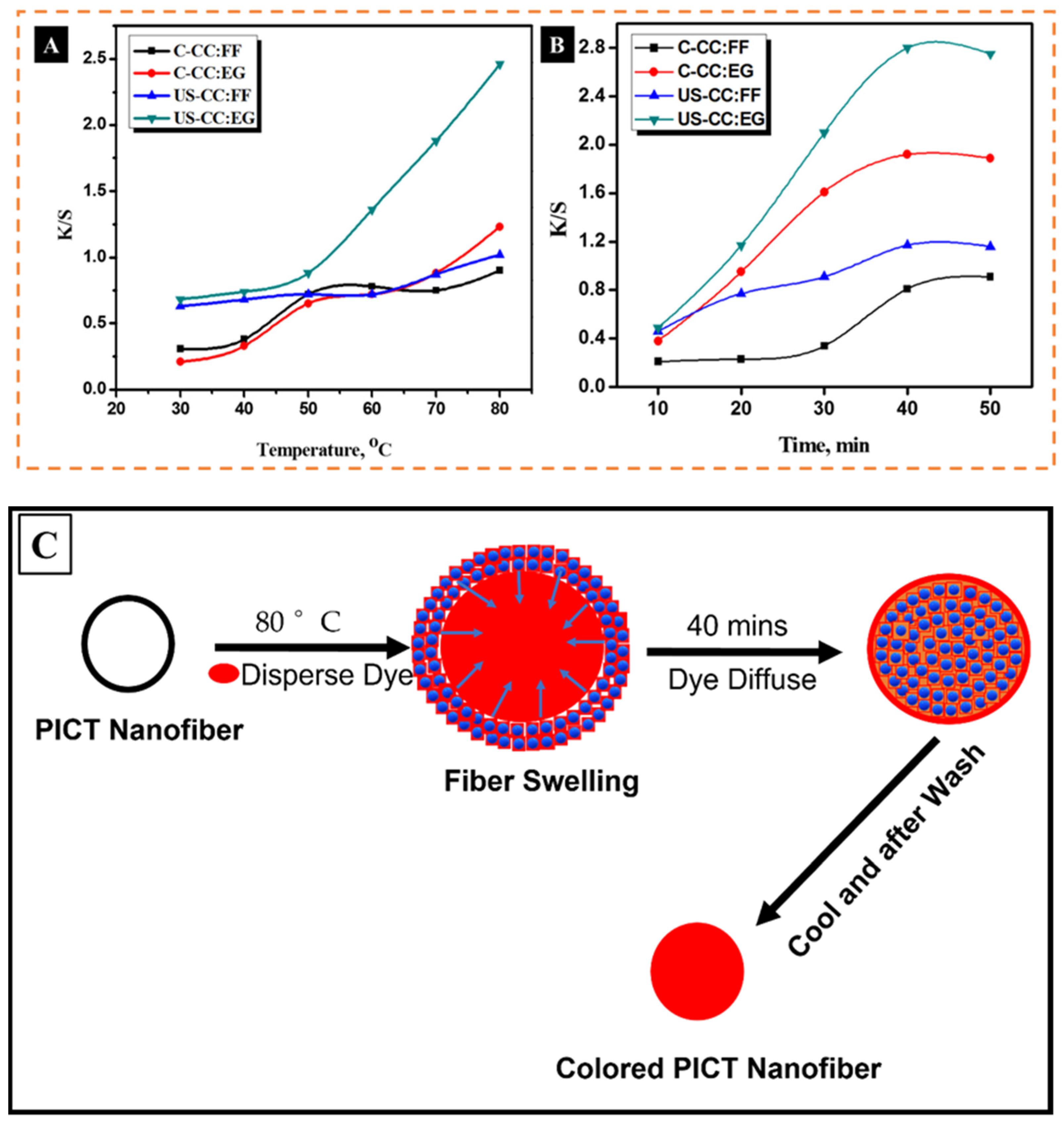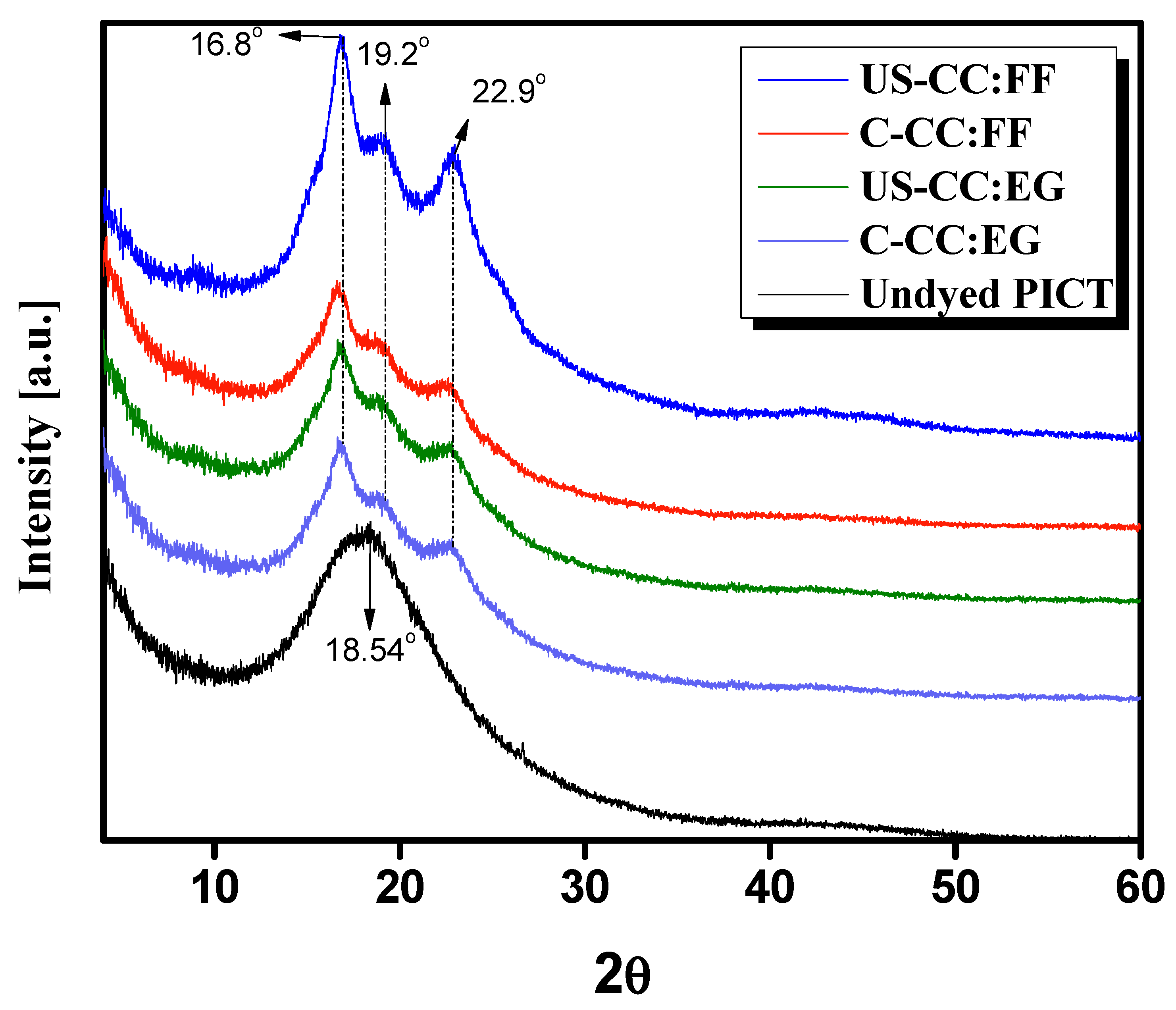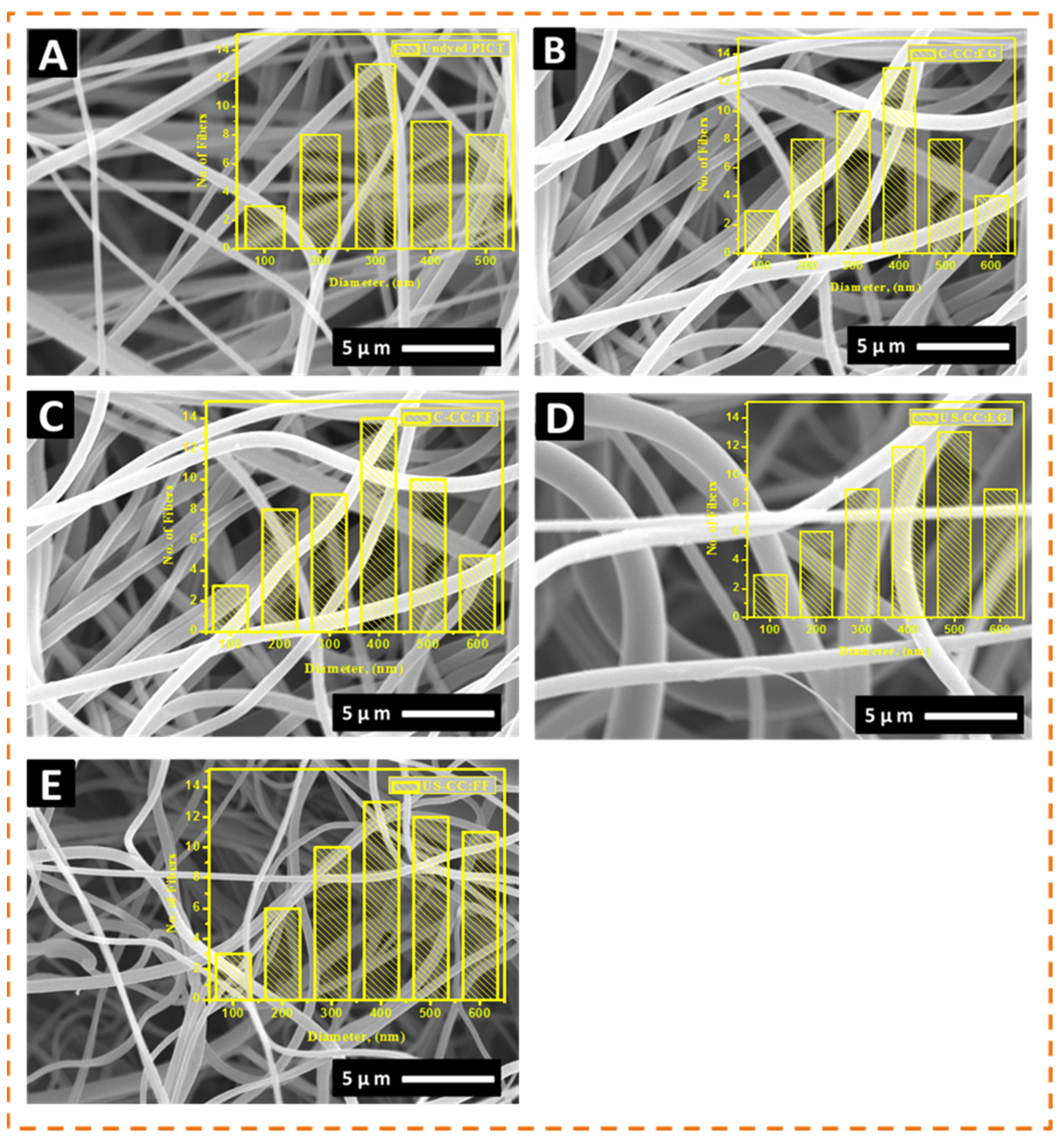Introducing Deep Eutectic Solvents as a Water-Free Dyeing Medium for Poly (1,4-cYclohexane Dimethylene Isosorbide Terephthalate) PICT Nanofibers
Abstract
:1. Introduction
2. Experimental Section
2.1. Materials
2.2. Methods
2.2.1. Preparing the PICT Nanofibers
2.2.2. Preparation of Deep Eutectic Solvents for Dyeing
2.2.3. Dyeing of PICT Nanofibers
2.2.4. Color Spectrophotometry
2.2.5. Physical Morphology and Chemical Changes
2.2.6. Color Fastness Tests
2.2.7. Tensile Strength Test
2.2.8. Shrinkage Test
2.2.9. Calculation of Electrical and Thermal Energy Consumption
3. Results and Discussion
3.1. Effect of Dyeing Temperature on PICT Nanofibers
3.2. Effect of Dyeing Time on PICT Nanofibers
3.3. Effect of Dye Concentration on PICT Nanofibers
3.4. Comparison between Conventional Dyed PICT and Ultrasonic Dyed PICT with Respect to Color Strength
3.5. FTIR Spectra of Dyed and Undyed Nanofibers
3.6. Change in Crystallinity of PICT Nanofiber after Dyeing
3.7. Morphological Observation of Dyed and Undyed PICT Nanofibers
3.8. Color Fastness Performance of Nanofibers
3.9. Shrinkage in PICT Nanofibers after Ultrasonic Dyeing
3.10. Young’s Modulus Values of Dyed and Undyed PICT Nanofibers
3.11. Electrical and Thermal Energy Consumption for Dyeing PICT Nanofiber
4. Conclusions
Author Contributions
Funding
Institutional Review Board Statement
Informed Consent Statement
Data Availability Statement
Conflicts of Interest
References
- Phan, D.-N.; Lee, H.; Choi, D.; Kang, C.-Y.; Im, S.S.; Kim, I.S. Fabrication of two polyester nanofiber types containing the biobased monomer isosorbide: Poly (ethylene glycol 1, 4-cyclohexane dimethylene isosorbide terephthalate) and poly (1, 4-cyclohexane dimethylene isosorbide terephthalate). Nanomaterials 2018, 8, 56. [Google Scholar] [CrossRef] [PubMed] [Green Version]
- Hussain, N.; Yousif, M.; Ali, A.; Mehdi, M.; Ullah, S.; Ullah, A.; Mahar, F.K.; Kim, I.S. A facile approach to synthesize highly conductive electrospun aramid nanofibers via electroless deposition. Mater. Chem. Phys. 2020, 255, 123614. [Google Scholar] [CrossRef]
- El-Ghazali, S.; Khatri, M.; Mehdi, M.; Kharaghani, D.; Tamada, Y.; Katagiri, A.; Kobayashi, S.; Kim, I. Fabrication of Poly(Ethylene-glycol 1,4-Cyclohexane Dimethylene-Isosorbide-Terephthalate) Electrospun Nanofiber Mats for Potential Infiltration of Fibroblast Cells. Polymers 2021, 13, 1245. [Google Scholar] [CrossRef]
- Khatri, M.; Ahmed, F.; Ali, S.; Mehdi, M.; Ullah, S.; Duy-Nam, P.; Khatri, Z.; Kim, I.S. Photosensitive nanofibers for data recording and erasing. J. Text. Inst. 2021, 112, 429–436. [Google Scholar] [CrossRef]
- Hussain, N.; Mehdi, M.; Yousif, M.; Ali, A.; Ullah, S.; Siyal, S.H.; Hussain, T.; Kim, I. Synthesis of Highly Conductive Electrospun Recycled Polyethylene Terephthalate Nanofibers Using the Electroless Deposition Method. Nanomaterials 2021, 11, 531. [Google Scholar] [CrossRef] [PubMed]
- Abbasi, A.; Memon, S.A.; Qureshi, R.F.; Mehdi, M.; Khatri, M.; Ahmed, F.; Khatri, Z.; Kim, I.S. Adsorptive defluoridation from aqueous solution using a novel blend of eggshell powder and chitosan nanofibers. Mater. Res. Express 2020, 7, 125005. [Google Scholar] [CrossRef]
- Hakro, R.A.; Mehdi, M.; Qureshi, R.F.; Mahar, R.B.; Khatri, M.; Ahmed, F.; Khatri, Z.; Kim, I.S. Efficient removal of reactive blue-19 dye by co-electrospun nanofibers. Mater. Res. Express 2021, 8, 055502. [Google Scholar] [CrossRef]
- Mehdi, M.; Qiu, H.; Dai, B.; Qureshi, R.; Hussain, S.; Yousif, M.; Gao, P.; Khatri, Z. Green Synthesis and Incorporation of Sericin Silver Nanoclusters into Electrospun Ultrafine Cellulose Acetate Fibers for Anti-Bacterial Applications. Polymers 2021, 13, 1411. [Google Scholar] [CrossRef]
- Rather, L.J.; Jameel, S.; Dar, O.A.; Ganie, S.A.; Bhat, K.A.; Mohammad, F. Advances in the sustainable technologies for water conservation in textile industries. In Water in Textiles and Fashion; Woodhead Publishing: Cambridge, UK, 2019; pp. 175–194. [Google Scholar]
- Wang, S.D.; Ma, Q.; Liu, H.; Wang, K.; Ling, L.Z.; Zhang, K.Q. Robust electrospinning cellulose acetate@ TiO 2 ultrafine fibers for dyeing water treatment by photocatalytic reactions. RSC Adv. 2015, 5, 40521–40530. [Google Scholar] [CrossRef]
- Abbott, A.P.; Capper, G.; Davies, D.L.; Rasheed, R.K.; Tambyrajah, V. Novel solvent properties of choline chloride/urea mixtures. Chem. Commun. 2003, 70–71. [Google Scholar] [CrossRef] [Green Version]
- Smith, E.L.; Abbott, A.; Ryder, K. Deep Eutectic Solvents (DESs) and Their Applications. Chem. Rev. 2014, 114, 11060–11082. [Google Scholar] [CrossRef] [Green Version]
- Elmaaty, T.A.; El-Aziz, E.A.; Ma, J.; El-Taweel, F.; Okubayashi, S. Eco-friendly disperse dyeing and functional finishing of nylon 6 using supercritical carbon dioxide. Fibers 2015, 3, 309–322. [Google Scholar] [CrossRef]
- Dunn, P.J. The importance of Green Chemistry in Process Research and Development. Chem. Soc. Rev. 2011, 41, 1452–1461. [Google Scholar] [CrossRef] [PubMed]
- Vaiano, V.; Sacco, O.; Sannino, D. Electric energy saving in photocatalytic removal of crystal violet dye through the simultaneous use of long-persistent blue phosphors, nitrogen-doped TiO2 and UV-light emitting diodes. J. Clean. Prod. 2019, 210, 1015–1021. [Google Scholar] [CrossRef]
- Mehdi, M.; Mahar, F.K.; Qureshi, U.A.; Khatri, M.; Khatri, Z.; Ahmed, F.; Kim, I.S. Preparation of colored recycled polyethylene terephthalate nanofibers from waste bottles: Physicochemical studies. Adv. Polym. Technol. 2018, 37, 2820–2827. [Google Scholar] [CrossRef]
- Mahar, F.K.; Mehdi, M.; Qureshi, U.A.; Brohi, K.M.; Zahid, B.; Ahmed, F.; Khatri, Z. Dyeability of recycled electrospun polyethylene terephthalate (PET) nanofibers: Kinetics and thermodynamic study. J. Mol. Liq. 2017, 248, 911–919. [Google Scholar] [CrossRef]
- Adeel, S.; Rehman, F.U.; Iqbal, M.U.; Habib, N.; Kiran, S.; Zuber, M.; Zia, K.M.; Hameed, A. Ultrasonic assisted sustainable dyeing of mordanted silk fabric using arjun (Terminalia arjuna) bark extracts. Environ. Prog. Sustain. Energy 2019, 38, S331–S339. [Google Scholar] [CrossRef]
- Adeel, S.; Zia, K.M.; Abdullah, M.; Rehman, F.-U.; Salman, M.; Zuber, M. Ultrasonic assisted improved extraction and dyeing of mordanted silk fabric using neem bark as source of natural colourant. Nat. Prod. Res. 2019, 33, 2060–2072. [Google Scholar] [CrossRef] [PubMed]
- Larik, S.A.; Khatri, A.; Ali, S.; Kim, S.H. Batchwise dyeing of bamboo cellulose fabric with reactive dye using ultrasonic energy. Ultrason. Sonochem. 2015, 24, 178–183. [Google Scholar] [CrossRef]
- Khatri, M.; Ahmed, F.; Jatoi, A.W.; Mahar, R.B.; Khatri, Z.; Kim, I.S. Ultrasonic dyeing of cellulose nanofibers. Ultrason. Sonochemistry 2016, 31, 350–354. [Google Scholar] [CrossRef]
- Ullah, S.; Hashmi, M.; Hussain, N.; Ullah, A.; Sarwar, M.N.; Saito, Y.; Kim, S.H.; Kim, I.S. Stabilized nanofibers of polyvinyl alcohol (PVA) crosslinked by unique method for efficient removal of heavy metal ions. J. Water Process. Eng. 2020, 33, 101111. [Google Scholar] [CrossRef]
- Jatoi, A.W.; Kim, I.S.; Ni, Q.Q. Ultrasonic energy-assisted coloration of polyurethane nanofibers. Appl. Nanosci. 2018, 8, 1505–1514. [Google Scholar] [CrossRef]
- Hussain, N.; Ullah, S.; Sarwar, M.N.; Hashmi, M.; Khatri, M.; Yamaguchi, T.; Khatri, Z.; Kim, I.S. Fabrication and Characterization of Novel Antibacterial Ultrafine Nylon-6 Nanofibers Impregnated by Garlic Sour. Fibers Polym. 2020, 21, 2780–2787. [Google Scholar] [CrossRef]
- Khatri, Z.; Khatri, A.; Saleem, U.; Mayakrishnan, G.; Kim, B.S.; Wei, K.; Kim, I.S. Pad dyeing of cellulose acetate nanofibres with disperse dyes. Coloration Technol. 2013, 129, 159–163. [Google Scholar] [CrossRef]
- Khatri, Z.; Arain, R.A.; Jatoi, A.W.; Mayakrishnan, G.; Wei, K.; Kim, I.S. Dyeing and characterization of cellulose nanofibers to improve color yields by dual padding method. Cellulose 2013, 20, 1469–1476. [Google Scholar] [CrossRef]
- Khatri, Z.; Ahmed, F.; Jhatial, A.K.; Abro, M.I.; Mayakrishnan, G.; Kim, I.-S. Cold pad-batch dyeing of cellulose nanofibers with reactive dyes. Cellulose 2014, 21, 3089–3095. [Google Scholar] [CrossRef]
- Khatri, M.; Hussain, N.; El-Ghazali, S.; Yamamoto, T.; Kobayashi, S.; Khatri, Z.; Ahmed, F.; Kim, I.S. Ultrasonic-assisted dyeing of silk fibroin nanofibers: An energy-efficient coloration at room temperature. Appl. Nanosci. 2020, 10, 917–930. [Google Scholar] [CrossRef]
- Chen, Z.; Hay, J.; Jenkins, M. FTIR spectroscopic analysis of poly(ethylene terephthalate) on crystallization. Eur. Polym. J. 2012, 48, 1586–1610. [Google Scholar] [CrossRef]
- Morris, M.; McHurdie, H.F.; Eloise, H.; Paretzkin, B.; Parker, H.S.; Panagiotopoulos, N.C.; Hubbard, C.R. Standard X-ray Diffraction Powder Patterns, NBS Monograph 25, Section 18, Data for 58 Substances; National Bureau of Standards: Gaithersburg, MA, USA, 1981; pp. 64–65. [Google Scholar]







| Dye Class | Method | Light Fastness (20 h) | Washing Fastness | Washing Fastness (Staining on Different Fibers) | |||||
|---|---|---|---|---|---|---|---|---|---|
| CT | CO | PA | PES | PAC | WO | ||||
| Red-167:1 | C-CC:EG | 2 | 4 | 4/3 | 4/5 | 3 | 4 | 5 | 5 |
| US-CC:EG | 2 | 4/3 | 4/5 | 5 | 3/4 | 4 | 5 | 5 | |
| C-CC:FF | 2 | 4 | 4 | 4/5 | 2/3 | 3/4 | 5 | 5 | |
| US-CC:FF | 2 | 4/5 | 5 | 4/5 | 3/4 | 4 | 5 | 4/5 | |
| Shrinkage | Conventional Dyeing | Ultrasonic Dyeing | ||
|---|---|---|---|---|
| CC:FF | CC:EG | CC:FF | CC:EG | |
| Lengthwise | 13% | 16% | 18% | 23% |
| Widthwise | 17% | 19% | 21% | 26% |
| (A) Method | Temperature (°C) | Time (min) | Total Consumption (Joules Per Second J/sec) | Saving Energy (%) |
|---|---|---|---|---|
| C-CC:EG US-CC:EG | 80 | 50 | 480,000 | 58.75 |
| 60 | 40 | 81,000 | ||
| C-CC:FF US-CC:FF | 80 | 60 | 480,000 | 56.6 |
| (B) Method | Temperature (°C) | Mass of Liquor in g | Total Consumption/(Joules Per Second J/sec) | Saving Energy (in %) |
| US-CC:EG | 80 | 0.01 | 82.86 | 25.4 |
| C-CC:EG | 80 | 0.01 | 110.48 | |
| US-CC: FF | 60 | 0.01 | 187 | 25 |
| C-CC: FF | 60 | 0.04 | 250.16 |
Publisher’s Note: MDPI stays neutral with regard to jurisdictional claims in published maps and institutional affiliations. |
© 2021 by the authors. Licensee MDPI, Basel, Switzerland. This article is an open access article distributed under the terms and conditions of the Creative Commons Attribution (CC BY) license (https://creativecommons.org/licenses/by/4.0/).
Share and Cite
Hussain, N.; Hussain, S.; Mehdi, M.; Khatri, M.; Ullah, S.; Khatri, Z.; Van Langenhove, L.; Kim, I.S. Introducing Deep Eutectic Solvents as a Water-Free Dyeing Medium for Poly (1,4-cYclohexane Dimethylene Isosorbide Terephthalate) PICT Nanofibers. Polymers 2021, 13, 2594. https://doi.org/10.3390/polym13162594
Hussain N, Hussain S, Mehdi M, Khatri M, Ullah S, Khatri Z, Van Langenhove L, Kim IS. Introducing Deep Eutectic Solvents as a Water-Free Dyeing Medium for Poly (1,4-cYclohexane Dimethylene Isosorbide Terephthalate) PICT Nanofibers. Polymers. 2021; 13(16):2594. https://doi.org/10.3390/polym13162594
Chicago/Turabian StyleHussain, Nadir, Sadam Hussain, Mujahid Mehdi, Muzamil Khatri, Sana Ullah, Zeeshan Khatri, Lieva Van Langenhove, and Ick Soo Kim. 2021. "Introducing Deep Eutectic Solvents as a Water-Free Dyeing Medium for Poly (1,4-cYclohexane Dimethylene Isosorbide Terephthalate) PICT Nanofibers" Polymers 13, no. 16: 2594. https://doi.org/10.3390/polym13162594
APA StyleHussain, N., Hussain, S., Mehdi, M., Khatri, M., Ullah, S., Khatri, Z., Van Langenhove, L., & Kim, I. S. (2021). Introducing Deep Eutectic Solvents as a Water-Free Dyeing Medium for Poly (1,4-cYclohexane Dimethylene Isosorbide Terephthalate) PICT Nanofibers. Polymers, 13(16), 2594. https://doi.org/10.3390/polym13162594












